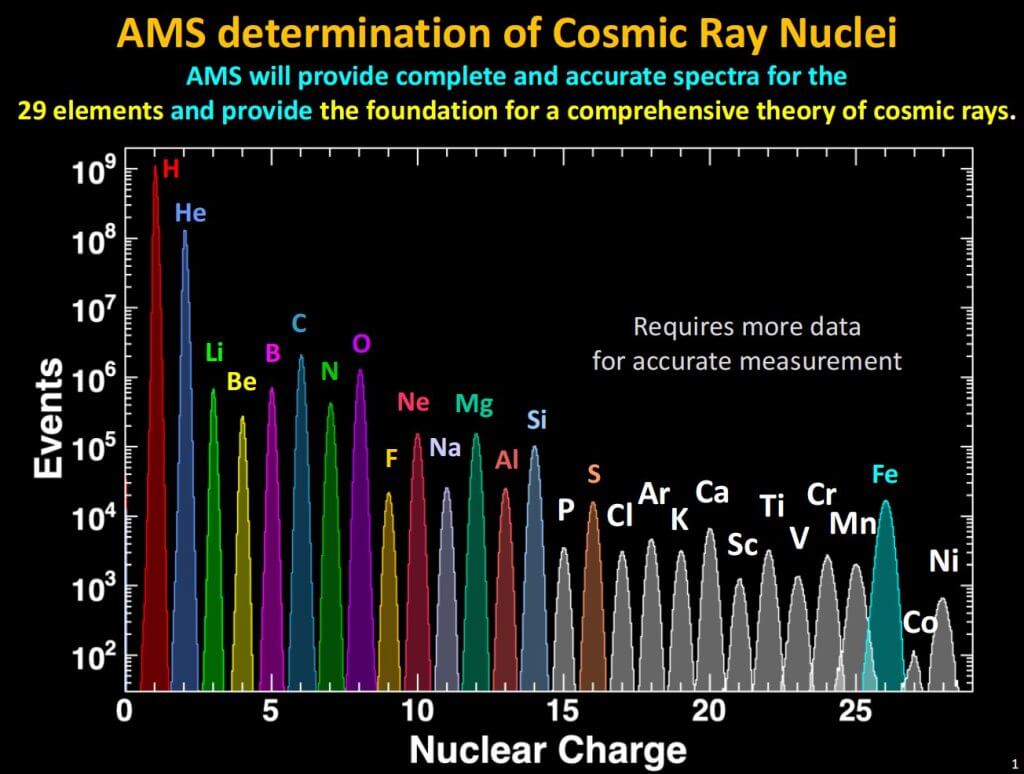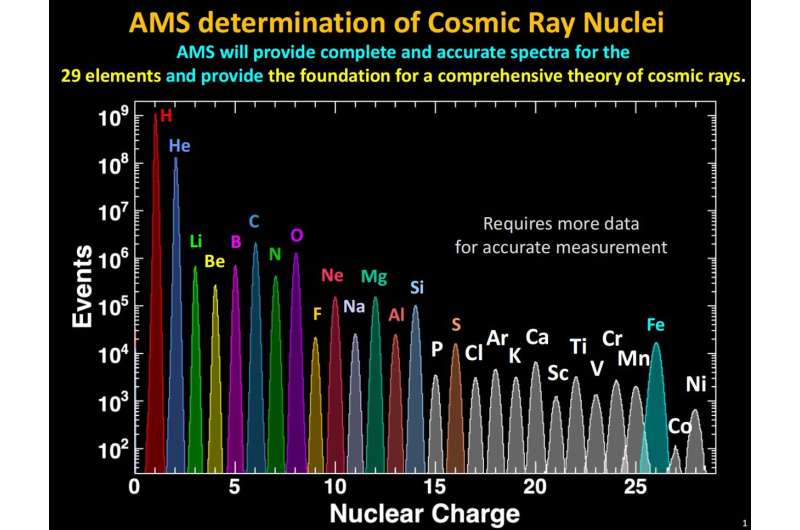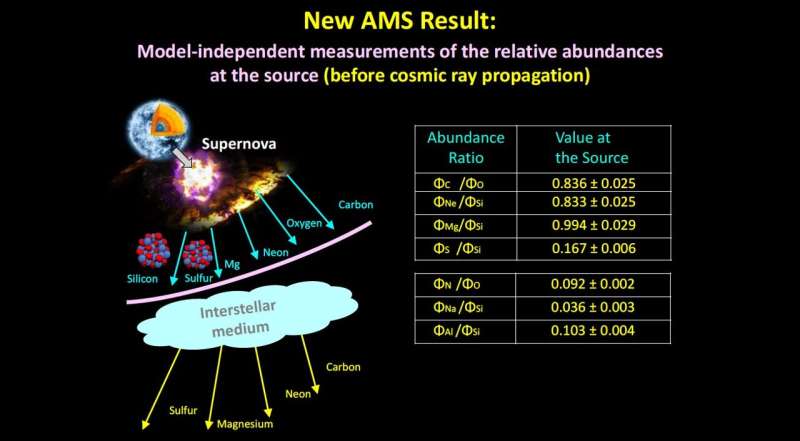
Research group unveils properties of cosmic-ray sulfur and the composition of other primary cosmic rays (Image Credit: Phys.org)

Charged cosmic rays, high-energy clusters of particles moving through space, were first described in 1912 by physicist Victor Hess. Since their discovery, they have been the topic of numerous astrophysics studies aimed at better understanding their origin, acceleration and propagation through space, using satellite data or other experimental methods.
The Alpha Magnetic Spectrometer (AMS) collaboration, a large research group analyzing data collected by a large magnetic spectrometer in space, recently gathered new insight about the properties and composition of specific types of cosmic rays. In a new paper, published in Physical Review Letters (PRL), they specifically unveiled the composition of primary cosmic-ray carbon, neon, and magnesium, along with the composition and properties of cosmic-ray sulfur.
“Pioneering experiments studying cosmic rays have typically an error of 30% to 50% and mostly at the kinetic energy below 50 Giga electron-volts per nucleon,” Samuel Ting, spokesperson for the AMS Collaboration, told Phys.org. “These large error measurements provide important information that agrees with many theoretical models. The Alpha Magnetic Spectrometer experiment on the International Space Station provides percent accuracy measurements of elementary particles (electrons, positrons, protons, and antiprotons) and all elements of the periodic table up to kinetic energy of more than 1,000 Giga electron-volts per nucleon.”
Some of the recent measurements collected by the AMS detector have been difficult to explain using existing theoretical physics models. For instance, by measuring the rigidity (i.e., momentum/charge) of all charged particles in the rays, the AMS detector gathered data shedding new light on the properties of two different kinds of charged cosmic rays, which the researchers dubbed primary and secondary rays.
“Primary cosmic rays (e.g., He, C, O, Ne, Mg, Si, S, Fe, …) nuclei are synthesized in stars and accelerated at astrophysical sources like supernovae, and secondary cosmic rays (e.g., Li, Be, B, F, …) nuclei are produced in the interactions of the primary cosmic ray with the interstellar media,” Ting explained. “Our recent work featured in PRL was inspired by our discovery of unique properties of cosmic rays in two previous publications.”
In a previous paper, the AMS Collaboration showed that primary cosmic-ray fluxes containing Ne, Mg and Si had an identical rigidity dependence above 86.5 Giga volts, which differed significantly from the rigidity dependence of primary cosmic rays containing He, C, O, and Fe particles. This suggests that primary cosmic rays can be divided in at least two sub-classes, which the team dubbed Ne-Mg-Si and He-C- O-Fe.

“So far, little is known about the properties of the sulfur cosmic rays,” Ting said. “Precision studies focusing on the properties of the cosmic sulfur, such as our new work, could provide new insights into the primary cosmic rays, helping us to unveil how many classes of primary cosmic rays exist.”
In another previous work, Ting and his collaborators found evidence suggesting that N, Na and Al cosmic rays are combinations of primary and secondary cosmic rays. They then precisely measured the fluxes of these cosmic rays over a wide rigidity range (i.e., from a few Giga volts to Tera volts) and analyzed their spectrum properties, to determine their unique primary and secondary components.
“For instance, the Na/Si and Al/Si abundance ratios at the source were measured directly as 0.036±0.003 and 0.103±0.004, respectively,” Ting said. “These measurements are independent of cosmic ray models. In our current publication we extended this method to measure the primary and secondary compositions of C, Ne, Mg, and S, which are traditionally assumed to be primary cosmic rays. Unexpectedly, we found that these elements all have sizeable secondary contributions from collision of heavier cosmic rays with the interstellar media.”
The AMS relies on a highly precise magnetic spectrometer that is generally used to conduct experiments on Earth, for instance aiding the search for fundamental particles using accelerators. It is comprised of six detecting elements that independently collect data about the charge, mass, momentum and energy of elementary particles and nuclei.
AMS is currently the only magnetic spectrometer situated in space, with researchers on Earth closely and continuously monitoring the functioning of each of its six elements to ensure that it operates reliably. Before it was sent to space, specifically to the International Space Station, in 2011, the spectrometer was carefully calibrated using different CERN particle accelerators.
“To ensure the accuracy and reliability of the results the raw data were analyzed independently by two to four international research groups,” Ting said. “By analyzing the first 10 years of the AMS data, i.e., about 200 billion cosmic rays, we observed that above 90 Giga volts the rigidity dependence of sulfur flux in cosmic rays is identical to the rigidity dependence of the Ne-Mg-Si fluxes, which is different from the He-C-O-Fe fluxes rigidity dependence. This shows that S, unexpectedly, belongs to the Ne-Mg-Si class of primary cosmic rays.”

Analyzing data related to 200 billion cosmic rays passing through six different detectors was a time-consuming and arduous task. Ultimately, the accuracy of the data was verified and cross-checked by four independent research teams located in Italy, Switzerland, China and the United States.
“We also found that the traditional primary cosmic rays S, Ne, Mg, and C all have sizeable secondary components. Sulfur, together with C, Ne, and Mg cosmic nuclei all can be presented as a sum of primary component (before propagation in Milky Way) and secondary component (during and after propagation),” Ting said, “The abundance ratio at the cosmic ray source for S/Si is 0.167±0.006, for Ne/Si is 0.833±0.025, for Mg/Si is 0.994±0.029, and for C/O is 0.836±0.025. These direct measurements are independent of cosmic ray models.”
Notably, the AMS Collaboration was the first to accurately measure the flux of S in the cosmos from a few Giga volts to Tera volts. Their findings greatly contribute to the understanding of cosmic rays, their composition and characteristics.
The analyses carried out by the AMS collaboration ultimately suggest that the primary and secondary contributions of primary of S, C, Ne and Mg cosmic-ray fluxes are markedly different to those of N, Na and Al fluxes. Their findings, none of which was predicted by existing cosmic ray models, could collectively help to better understand the nucleosynthesis in stars as well as the origin and propagation of cosmic rays.
“AMS will now continue precision study of the cosmic elements,” Ting added. “We are currently upgrading our detector by increasing its acceptance by 300%. By 2030, we will explore the properties of the remaining heavy cosmic ray elements, marked in white. Thus, by 2030 we will provide accurate and comprehensive information on cosmic ray origin and propagation. This will uncover the mysteries of cosmic rays, such as where and how are they created, or how they reach us. In our next works, we plan to study the origin of the dark matter by precision measurements of electrons, positrons, antiprotons, and antideuterons. By 2030, our study of positron, electron, antiproton, and antideuteron spectra together with the study of the positron anisotropy will provide an explanation of the current unexpected AMS results.”
While analyzing AMS data, Ting and his collaborators have also observed several particles that could be viable heavy antimatter candidates, including antihelium. They thus plan to also continue searching for more of these particles, particularly anticarbon and antioxygen. Concurrently, they are analyzing the daily flux variations of all the cosmic rays in the heliosphere over both 11 years and 22 years solar cycles, which could yield other interesting discoveries.
More information:
M. Aguilar et al, Properties of Cosmic-Ray Sulfur and Determination of the Composition of Primary Cosmic-Ray Carbon, Neon, Magnesium, and Sulfur: Ten-Year Results from the Alpha Magnetic Spectrometer, Physical Review Letters (2023). DOI: 10.1103/PhysRevLett.130.211002
Journal information:
Physical Review Letters
© 2023 Science X Network
Research group unveils properties of cosmic-ray sulfur and the composition of other primary cosmic rays (2023, July 7)
retrieved 27 September 2023
from https://phys.org/news/2023-07-group-unveils-properties-cosmic-ray-sulfur.html
part may be reproduced without the written permission. The content is provided for information purposes only.





